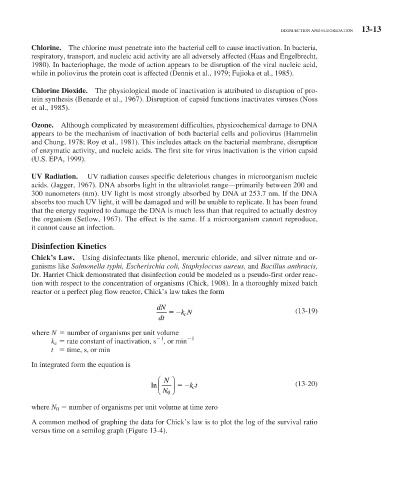Page 518 - Water and wastewater engineering
P. 518
DISINFECTION AND FLUORIDATION 13-13
Chlorine. The chlorine must penetrate into the bacterial cell to cause inactivation. In bacteria,
respiratory, transport, and nucleic acid activity are all adversely affected (Haas and Engelbrecht,
1980). In bacteriophage, the mode of action appears to be disruption of the viral nucleic acid,
while in poliovirus the protein coat is affected (Dennis et al., 1979; Fujioka et al., 1985).
Chlorine Dioxide. The physiological mode of inactivation is attributed to disruption of pro-
tein synthesis (Benarde et al., 1967). Disruption of capsid functions inactivates viruses (Noss
et al., 1985) .
Ozone. Although complicated by measurement difficulties, physicochemical damage to DNA
appears to be the mechanism of inactivation of both bacterial cells and poliovirus (Hammelin
and Chung, 1978; Roy et al., 1981). This includes attack on the bacterial membrane, disruption
of enzymatic activity, and nucleic acids. The first site for virus inactivation is the virion capsid
(U.S. EPA, 1999).
UV Radiation. UV radiation causes specific deleterious changes in microorganism nucleic
acids. (Jagger, 1967). DNA absorbs light in the ultraviolet range—primarily between 200 and
300 nanometers (nm). UV light is most strongly absorbed by DNA at 253.7 nm. If the DNA
absorbs too much UV light, it will be damaged and will be unable to replicate. It has been found
that the energy required to damage the DNA is much less than that required to actually destroy
the organism (Setlow, 1967). The effect is the same. If a microorganism cannot reproduce,
it cannot cause an infection.
Disinfection Kinetics
Chick’s Law. Using disinfectants like phenol, mercuric chloride, and silver nitrate and or-
ganisms like Salmonella typhi, Escherischia coli, Staphyloccus aureus, and Bacillus anthracis,
Dr. Harriet Chick demonstrated that disinfection could be modeled as a pseudo-first order reac-
tion with respect to the concentration of organisms (Chick, 1908). In a thoroughly mixed batch
reactor or a perfect plug flow reactor, Chick’s law takes the form
dN
kN (13-19)
c
dt
where N number of organisms per unit volume
1
1
k c rate constant of inactivation, s , or min
t time, s, or min
In integrated form the equation is
⎛ N ⎞
ln ⎜ ⎝ ⎟ ⎠ kt c (13-20)
N 0
where N 0 number of organisms per unit volume at time zero
A common method of graphing the data for Chick’s law is to plot the log of the survival ratio
versus time on a semilog graph ( Figure 13-4 ).

